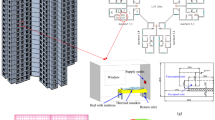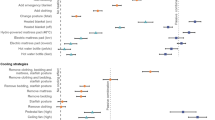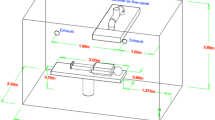Abstract
As an energy-saving equipment, task/ambient air conditioning (TAC) system was widely used in slee** environment in recent years. The TAC can deliver cooling air directly to the slee** person, resulting that the micro climate around the human body becomes very critical in the evaluation of human beings’ thermal comfort. Different from sitting and standing, slee** human body is always at lying posture, and thus at a lower metabolic rate than at waking status. To understand the heat balance between a slee** body and the surrounding environment, investigation on the heat loss of human body becomes necessary. Hence, a numerical study on the body heat loss characteristics of a thermal manikin at slee** state in a bedroom utilizing a TAC system was carried out. The convective heat transfer, radiative heat transfer, evaporative heat loss from skin and respiratory heat loss and their ratios were quantitatively analyzed. The results indicate that the convective heat transfer took the first place, accounting for about 80% of the total heat loss, and Latent heat loss accounted for 15.9%–21% of the total heat loss. In addition, the heat loss at different supply conditions was numerically studied. Results showed that the supply air temperature, flowrate and humidity play different effects on body heat loss. Contributions of this study are meaningful for the accurate control of micro climate of human activities.














Similar content being viewed by others
Abbreviations
- A D :
-
Dubois surface area (m2)
- C :
-
Convective heat loss (W m−2)
- C p,a :
-
Specific heat of air (J kg−1 K−1)
- C res :
-
Respiratory heat loss (Sensible) (W m−2)
- E res :
-
Respiratory heat loss (Latent) (W m−2)
- E sk :
-
Evaporative heat loss from skin (W m−2)
- f cl :
-
Clothing area factor
- G ω :
-
Generation of ω
- \(\tilde{G}_{\text{k}}\) :
-
Generation of turbulence kinetic energy due to mean velocity gradients
- h′ :
-
Overall sensible heat transfer coefficient (W m−2 K−1)
- h conv :
-
Convective heat transfer coefficient (W m−2 K−1)
- h e :
-
Evaporative heat transfer coefficient (W m−2 K−1)
- I a :
-
Thermal insulation (clo)
- i m :
-
Total vapor permeation efficiency
- k :
-
Turbulent kinetic energy (J kg−1)
- K res :
-
Proportionality constant
- L R :
-
Lewis ratio (K kPa−1)
- M :
-
Metabolic heat production (W m−2)
- \(\dot{m}_{\text{res}}\) :
-
Pulmonary ventilation rate (kg s−1)
- P a :
-
Water vapor pressure in ambient air (kPa)
- P sk,s :
-
Water vapor pressure in saturated air at tsk (kPa)
- P t :
-
Ambient pressure (kPa)
- Q latent :
-
Latent heat loss from thermal manikin (W m−2)
- Q r :
-
Radiative heat loss (W m−2)
- Q res :
-
Respiratory heat loss (W m−2)
- Q s :
-
Supply air flow rate (L s−1)
- Q total :
-
Total heat loss from thermal manikin (W m−2)
- R :
-
Radiative heat loss (W m−2)
- R e,cl :
-
Evaporative heat transfer resistance of clothing layer (W m−2)
- R e,t :
-
Total evaporative resistance (W m−2)
- R t :
-
Total equivalent thermal resistance between body and surrounding environment (including clothing and boundary resistance) (m2 K W−1)
- RHa :
-
Relative humidity in ambient air (%)
- RHs :
-
Relative humidity in supply air (%)
- S k :
-
User defined source term
- S ω :
-
User defined source term
- t :
-
Air temperature at a measurement position (ºC)
- t a :
-
Ambient air temperature (ºC)
- t ex :
-
Exhaled temperature (ºC)
- T s :
-
Supply air temperature (ºC)
- t sk :
-
Average skin temperature (ºC)
- t uz :
-
Average air temperature in an unoccupied zone (ºC)
- u :
-
Air velocity (m s−1)
- v a :
-
Air velocity in the ambient environment (m s−1)
- W :
-
Workload (W m−2)
- w :
-
Skin wetness
- W a :
-
Humidity ratio of inspired air (ambient air) (kg kg−1)
- W ex :
-
Humidity ratio of exhaled air (kg kg−1)
- Yk :
-
Dissipation of k
- Y ω :
-
Dissipation of ω
- ρ :
-
Density (kg m−3)
- ω :
-
Specific dissipation rate (s−1)
- Γ k :
-
Effective diffusivity of k (m2 s−1)
- Γ ω :
-
Effective diffusivity of ω (m2 s−1)
References
Pan DM, Chan MY, **a L, Xu XG, Deng SM. Performance evaluation of a novel bed-based task/ambient conditioning (TAC) system. Energ Build. 2012;44:54–62.
Mao N, Song M, Deng S, Pan D, Chen S. Experimental and numerical study on air flow and moisture transport in slee** environments with a task/ambient air conditioning (TAC) system. Energ Build. 2016;133:596–604.
Mao N, Pan D, Chan M, Deng S. Experimental and numerical studies on the performance evaluation of a bed-based task/ambient air conditioning (TAC) system. Appl Energ. 2014;136:956–67.
Du J, Chan M, Deng S. An experimental study on the performances of a radiation-based task/ambient air conditioning system applied to slee** environments. Energ Build. 2017;139:291–301.
Lan L, Lian Z, Zhou X, et al. Pilot study on the application of bedside personalized ventilation to slee** people. Build Environ. 2013;67:160–6.
Nielsen M, Pedersen L. Studies on the heat loss by radiation and convection from the clothed human body. Acta Physiol Scand. 1953;27:272–94.
Kurazumi Y, Tsuchikawa T, Ishii J, Fukagawa K, Yamato Y, Mastsubara N. Radiative and convective heat transfer coefficients of the human body in natural convection. Build Environ. 2008;43:2142–53.
de Dear RJ, Arens E, Hui Z, Oguro M. Convective and radiative heat transfer coefficients for individual human body segments. Int J Biometeorol. 1997;40:141–56.
Li C, Ito K. Numerical and experimental estimation of convective heat transfer coefficient of human body under strong forced convective flow. J Wind Eng Ind Aerodyn. 2014;126:107–17.
Shenoy SK, Diller TE. Heat flux measurements from a human forearm under natural convection and isothermal jets. Int J Heat Mass Trans. 2018;123:728–37.
Ono T, Murakami S, Ooka R, Omori T. Numerical and experimental study on convective heat transfer of the human body in the outdoor environment. J Wind Eng Ind Aerod. 2008;96:1719–32.
Sorensen DN, Voigt LK. Modelling flow and heat transfer around a seated human body by computational fluid dynamics. Build Environ. 2003;38:753–62.
Sevilgen G, Kilic M. Numerical analysis of air flow, heat transfer, moisture transport and thermal comfort in a room heated by two-panel radiators. Energ Build. 2011;43:137–46.
Martinho N, Lopes A, da Gameiro SM. Evaluation of errors on the CFD computation of air flow and heat transfer around the human body. Build Environ. 2012;58:58–69.
Bilgili M, Simsek E, Sahin B, Yasar A, Ozbek A. Estimation of human heat loss in five Mediterranean regions. Physiol Behav. 2015;149:61–8.
Sankar M, Venkatachalappa M, Shivakumara IS. Effect of magnetic field on natural convection in a vertical cylindrical annulus. Int J Eng Sci. 2006;44:1556–70.
Sankar M, Park J, Kim D, Do Y. Numerical study of natural convection in a vertical porous annulus with an internal heat source: effect of discrete heating. Numer Heat Trans A Appl. 2013;63:687–712.
Quintela D, Gaspar A, Borges C. Analysis of sensible heat exchanges from a thermal manikin. Eur J Appl Physiol. 2004;92:663–8.
Mao N, Hao J, He T, Song M, Xu Y, Deng S. PMV-based dynamic optimization of energy consumption for a residential task/ambient air conditioning system in different climate zones. Renew Energ. 2019;142:41–5.
Mao N, Pan DM, Deng SM, Chan MY. Thermal, ventilation and energy saving performance evaluations of a ductless bed-based task/ambient air conditioning (TAC) system. Energ Build. 2013;66:297–305.
Tong Z, Chen Y, Malkawi A. Defining the Influence Region in neighborhood -scale CFD simulations for natural ventilation design. Appl Energ. 2016;182:625–33.
Sankar M, Do Y. Numerical simulation of free convection heat transfer in a vertical annular cavity with discrete heating. Int Commun Heat Mass Transf. 2020;37:600–6.
Sankar M, Do Y, Ryu S, Jang B. Cooling of heat sources by natural convection heat transfer in a vertical annulus. Numer Heat Trans A Appl. 2015;68:847–69.
ANSYS FLUENT User’s Guide, ANSYS, Inc. Southpointe 2010.
Raithby GD, Chui EH. A finite-volume method for predicting a radiant heat transfer in enclosures with participating media. J Heat Transf. 1990;112:415–23.
Fanger PO. Thermal comfort. Copenhagen: Danish Technical Press; 1970.
Lin ZP, Deng SM. A study on the thermal comfort in slee** environments in the subtropics-develo** a thermal comfort model for slee** environments. Build Environ. 2008;43:70–81.
ASHRAE ASHRAE handbook of fundamentals. 2009.
Gagge AP, Fobelets AP, Berglund LG. A standard predictive index of human response to the thermal environment. ASHRAE Trans. 1986;92(Pt. 2B):709–31.
McCullough EA, Jones BW, Tamura T. A data base for determining the evaporative resistance of clothing. ASHRAE Trans. 1989;95(Pt. 2):316–28.
McCutchan JW, Taylor CL. Respiratory heat exchange with varying temperature and humidity of inspired air. J Appl Physiol. 1951;1951(4):121–35.
Menter FR. Two-equation eddy-viscosity turbulence models for engineering applications. AIAA J. 1994;32:1598–605.
Stamou A, Katsiris I. Verification of a CFD model for indoor airflow and heat transfer. Build Environ. 2006;41:1171–81.
Zhai ZQ, Zhang Z, Zhang W, Chen QY. Evaluation of various turbulence models in predicting airflow and turbulence in enclosed environments by CFD: Part-1: summary of prevalent turbulence models. HVAC&R Res. 2005;13:853–70.
Chen Q, Srebric J. A procedure for verification, validation, and reporting of indoor environment CFD analysis. HAVC&R Res. 2002;8:201–16.
Omori T, Yang JH, Kato S, Murakami S. Coupled simulation of convection and radiation on thermal environment around an accurately shaped human body. In: Proceedings of the Room Vent 2004, 9th International Conference on Air Distribution in Rooms. Coimbra, Portugal, 6–8 September 2004.
Oguro M, Arens E, de Dear R, Zhang H, Katayama T. Convective heat transfer coefficients and clothing insulations for parts of the clothed human body under calm conditions. J Archit Plan Environ Eng. 2002;561:31–9.
Funding
The study was supported by Shandong Provincial Natural Science Foundation, China (No.: ZR201910240273), the Fundamental Research Funds for the Central Universities (No.: 18CX02077A), Research Foundation for Talents of China University of Petroleum (East China) (No.: YJ201501018).
Author information
Authors and Affiliations
Corresponding author
Ethics declarations
Conflict of interest
We declare that we have no financial and personal relationships with other people or organizations that can inappropriately influence our work. The content of this manuscript have not been copyrighted or published previously. The contents of this manuscript are not now under consideration for publication elsewhere.
Additional information
Publisher's Note
Springer Nature remains neutral with regard to jurisdictional claims in published maps and institutional affiliations.
Rights and permissions
About this article
Cite this article
Mao, N., Song, M. & Xu, Y. Numerical investigation on the heat flux properties of a thermal manikin in slee** environments applying task/ambient air conditioning. J Therm Anal Calorim 147, 1675–1688 (2022). https://doi.org/10.1007/s10973-020-10515-2
Received:
Accepted:
Published:
Issue Date:
DOI: https://doi.org/10.1007/s10973-020-10515-2




